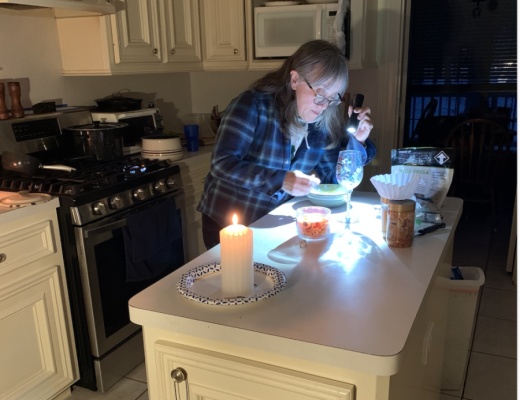Winter storms hit the week of Valentine’s Day, blanketing Texas with snow, sleet and subzero temperatures for days as rolling outages plunged millions into darkness.
In Montgomery County, nearly 60,000 customers of Entergy Texas—an electric provider that serves most of the county and the Conroe, Montgomery and Willis areas—were out of power Feb. 15, according to Entergy’s outage map. Some residents were out of power for days, and many experienced damages from burst pipes, including school districts, which reported up to $200,000 in damages.
Although scrutiny has been placed over the failure of the state’s electric grid during the storm, it is not clear if similar investigations will be taken for areas outside the grid, including the area served by Entergy.
Entergy is not part of the state grid that serves about 90% of Texans and is run by the Energy Reliability Council of Texas. Entergy is part of the Eastern Interconnection, which spans across other states, and its reliability coordinator is the Midcontinent Independent System Operator, which delivers power to 15 U.S. states and a Canadian province.
Officials statewide are calling for reforms and an investigation into ERCOT and the Public Utility Commission of Texas, the state agency that regulates electric, water and telecommunication utilities. Yet there is no apparent legal action or investigation underway into MISO or Entergy from state or local elected officials.
“There’s no excuses for [the failures],” Montgomery County Judge Mark Keough said. “[But] they worked as hard as they could in the time that they had.”
Some action against Entergy is being taken in the private sector: Houston-based attorney Tony Buzbee filed a lawsuit against the company that alleges the outages led to the death of an 11-year-old boy in Conroe. But Entergy may be largely protected from legal repercussions related to damages and injuries from outages, said Tommy Hastings, a medical malpractice lawyer in The Woodlands.
“I think it’s going to be very, very hard to hold Entergy liable for any personal injuries or property damages from the outages,” Hastings said.
Entergy officials said they are conducting a thorough post-event review of the steps they took and what could be done better in the future. They will also invest in infrastructure and technologies such as backup generators.
“[We will be] investing in improving our system not just for reliability but [also] further investment in grid resiliency,” said Allison Payne, senior communications specialist of Entergy Texas. “Those investments ... help us adapt and quickly respond to impacts to our system.”
Left in the dark
Entergy began periodic power outages across southeast Texas as directed by MISO in the early morning hours Feb. 15. It was a last-ditch effort to prevent more extensive outages that could severely cripple the power grid, according to Entergy.
The outages continued from Feb. 15 to around Feb. 20. Some Montgomery County residents reported to be out of power anywhere from a couple hours to days. Walden subdivision resident Maryrose Hearn said her power flitted in and out for hours before shutting down for over 30 hours.
“We had a small amount of firewood we used in a firepit outside as we sat in 10-degree weather trying to warm up,” she said.
Entergy has two major power plants in the Montgomery County area: the Lewis Creek plant and the new Montgomery County Power Station, which is located in Willis and achieved commercial operation Jan. 1.
Although one Lewis Creek unit kept running throughout the storm, the other went down due to the snow, ice and extreme cold, Payne said. The Willis power station briefly went down the morning of Feb. 15 but was returned online that afternoon. Transmission facilities also tripped offline but were restored later in the day Feb. 15 and early Feb 16.
“This, coupled with the high demand on the system due to the cold, prevented us from having adequate supply,” Payne said.
Entergy’s steps
Payne said Entergy and MISO fared better than the rest of the state, which was struggling to navigate its own catastrophe. By about 1:15 a.m. Feb. 15, the state’s electricity system had dropped perilously low and was less than five minutes away from a statewide blackout, which could have plunged Texans into darkness for weeks, ERCOT officials said.
“We did not see the same kind of sustained price spikes or the same level of outages that affected the ERCOT region,” Payne said.
For comparison, a total of 155,238 out of its 473,000 customers in Texas were affected by outages at the peak, the company stated, while CenterPoint Energy, an electric provider that serves portions of Montgomery and Harris counties, reported 1.42 million of its 2.4 million Texas customers were without power Feb. 15.
Entergy had winterized its power plants and transmission grid prior to and during the storm, including the addition of wind breaks, heaters and insulation, Payne said. Still, the company will be conducting a post-event review of the steps it took and what could have been done better.
Following the evaluation, Entergy will look into hardening its infrastructure against severe weather as well as investing in new technologies. For example, the company filed a request last year with the PUC to implement an initiative called Power Through, which would allow Entergy to partner with commercial businesses to install backup generators. Payne said Entergy is hoping for approval of the program by this fall.
“For example, grocery and drug stores equipped with these generators could remain open,” she said.
Entergy invested in its infrastructure following a series of power outages in 2019, when power outages in the county were up 49% compared to 2018, as well as after Hurricane Laura last August.
Lawsuits and liability
Disasters are becoming more common and more damaging, particularly in Texas, according to federal data. The National Oceanic and Atmospheric Administration found from 1980 to 2020, the United States experienced 285 climate-related disasters that caused over $1 billion in damage, 124 of which occurred in Texas.
“As the climate changes, history becomes a less reliable predictor of future conditions,” a 2020 report titled “MISO’s Response to the Reliability Imperative” said.
The report by MISO stated the entity has declared an increasing number of emergencies since the summer of 2016, and factors include high-demand conditions and more extreme temperatures and storms.
Meanwhile, ERCOT has come under fire; CEO Bill Magnus was fired, its board of directors resigned, and Texas House and Senate hearings were held to investigate the grid failure. When asked, state Rep. Will Metcalf, R-Conroe, did not say if similar scrutiny will be applied to Entergy or MISO but said there will be future discussions.
“ERCOT is 90% of the state of Texas, so that’s why they’re the first in our committee hearings,” he said. “We will definitely be continuing [conversations with Entergy and MISO].”
Buzbee’s lawsuit against Entergy alleges the death of the Conroe boy, having apparently died in his family’s mobile home after they lost power, was the result of the electric provider’s failure to prepare for the storm and its “rolling outages” that lasted days. It is not clear why the lawsuit also names ERCOT, and Buzbee’s office did not return requests for comment.
Similar lawsuits against other electric providers have also been filed, such as the suit against Dallas-based Oncor Electric that alleges the company is responsible for the death of an elderly man who froze without power, according to Androvett Legal Media and Marketing. A wrongful death lawsuit was also filed in Harris County against CenterPoint for the death of James Jones, whose battery-powered backup respirator ran dry after 24 hours of no power, according to the law firm Abraham Watkins.
Various lawsuits have also been filed against ERCOT for the failure of the state’s grid that left millions of Texans without power. While the Texas Supreme Court will decide if ERCOT can be held liable for the onslaught of legal issues it faces, it is unclear how lawsuits against electric providers such as Entergy will fare.
Hastings said plaintiffs’ best shot is to sue electric providers for gross negligence, which Buzbee’s lawsuit does allege. A 2002 Texas Supreme Court case upheld that an electrical provider can limit its liability for outages. According to Entergy’s contract for services filed with the PUC, there is no liability for negligence.
“I’ve had cases against Entergy; I’ve had cases against CenterPoint, and I can tell you that it’s a very high hurdle for a customer of an energy provider such as Entergy to bring a lawsuit for damages, even personal injuries and death,” Hastings said. “I think there will be some arguments made that it was gross negligence, and I think that’s the only argument you can make.”
Andrew Christman, Matt Dulin, Vanessa Holt and Christopher Neely contributed to this report.





